These studies were designed to determine the efficacy of InterDry® used in place of the standard treatments.
Patient description: 53-year-old female with morbid obesity (BMI 62.8), angina, pulmonary embolism, venous insufficiency and bipolar disorder.
Past treatments: Cleansing with a body wash followed by a lotion and an antifungal powder two times a day and as needed.
InterDry® protocol: Cleanse the skin with Bedside-Care® Foam. Place InterDry in the skin fold. Reposition as needed. Replace if soiled. Discard on day five (5).

Intertrigo under the left breast, which has been present for twelve (12) weeks. Symptoms included severe erythema, denudement, maceration, satellite lesions, odor and complaints of itching/burning.
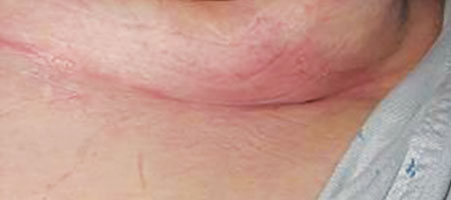
Complete resolution of denudement, maceration, satellite lesions, and odor. Slight erythema with dry flaking skin remains. No further complaints of itching/burning.
Patient description: 92-year-old female patient presented for care of venous stasis ulceration.
Past treatments: Prescription antifungal powder applied twice daily and an oral antifungal administered daily for five days. The rash persisted and she was then treated with an antifungal cream applied two times daily for two weeks. Treatments were not effective.
InterDry protocol: Two strips of InterDry® under each breast using a cotton sports bra to keep fabric in place.
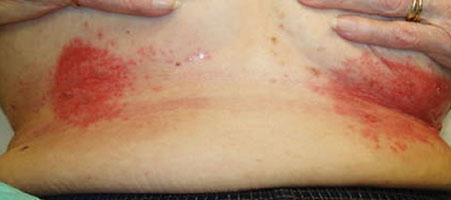
Persistent, painful rash underneath her breasts. Candidal intertrigo with erythematous papules, satellite lesions, denudement, weeping and a musty odor.
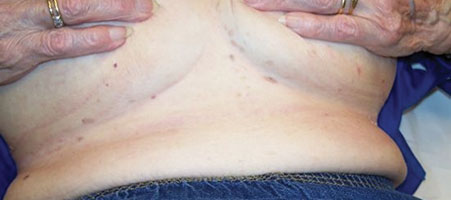
Patient followed up weekly with improvement noted at week 2 and resolution of symptoms and rash by week 3.
Patient description: 39-year-old female presented with grade II lymphedema of the right arm.
Past treatment: Over the counter antifungal powder.
InterDry protocol: Apply the silver coated textile over the affected area and leave it in place. She was allowed to remove the fabric for the duration of her shower.
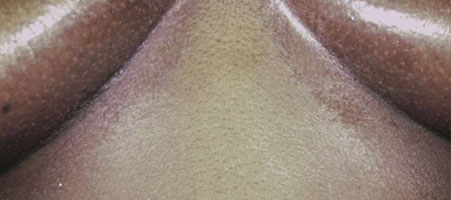
Patient complained of intense pruritus and burning under both breasts.
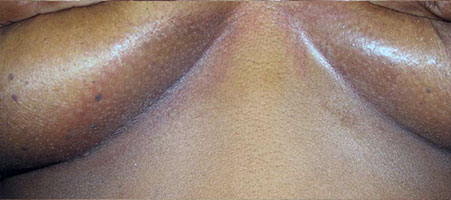
Skin dry but still with significant erythema present. No more pruritus or burning.
Patient description: 66-year-old, 425 lbs. (193 kg) male with congestive heart failure (CHF), a history of COPD, obstructed sleep apnea, chronic left leg ulcer and morbid obesity.
Past treatments: Patient had unsuccessfully tried to treat the area with creams that he found difficult to apply, expensive and were minimally effective in reducing his symptoms.
InterDry protocol: Moisture-wicking fabric with silver was applied on Day 1 by the WOC nurse with goals focused toward wicking excess moisture, reducing inflammation and in turn, reducing pain, itching, erythema, and eliminating odor-causing microorganisms.
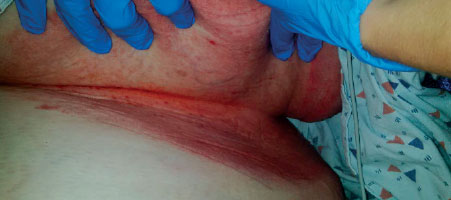
Erythema at the patient’s chest skin fold. Extreme pain, itching and odor.
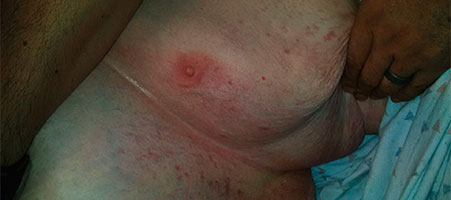
Almost complete elimination of symptoms. Reduced signs of inflammation, discomfort and odor.
1.Sibbald RG, Kelley J, Kennedy-Evans KL, Labrecque C, Waters N. A practical approach to the prevention and management of intertrigo, or moisture-associated skin damage, due to perspiration: expert consensus on best practice. Wound Care Canada – supplement. 2013;11(2):1-21. Accessible at www.woundscanada.ca/docman/public/71-bpr-prevention-management-fall-2013/file.
2. Brown J, Wimpenny P, Maughan H. Skin problems in people with obesity. Nurs. Stand. 2004;18(35):38-42.
3. Janniger CK, Schwartz RA, Szepietowski JC, Reich A. Intertrigo and common secondary skin infections. Am Fam Physician. 2005;72(5):833-838.
4. O’Dell ML. Skin and wound infections: an overview. Am Fam Physician. 1998;57(10):2424-2432.
5. Haberer P. When ITD hits home: best practice tips for using a moisture-wicking fabric with silver for intertriginous dermatitis. 7th Annual Symposium on Advanced Wound Care, Southeast Region of the WOCN society. September, 2015.
6. Vorbeck, E. Evaluation of a skin fold management textile with antimicrobial silver complex in a variety of case studies. Mayo Health System, Minnesota.
7. Kennedy-Evans KL, Viggiano B, Henn T, Smith D. Multi-site feasibility study using a new textile with silver for management of skin conditions located in skin folds. Poster presented at: 20th Annual Symposium on Advanced Wound Care; April 28 – May 1, 2007; Tampa, FL and 39th WOCN® Society Annual Conference; June 9-13, 2007; Salt Lake City, UT.
8. Vorbeck, E. Evaluation of a skin fold management textile with antimicrobial silver complex in a variety of case studies. Mayo Health System, Minnesota.
9. Maus E, Baylor D, Benavides S, Kinder L, Fife C, Guilliod R, Hawkins T, Robles M, Smith L, Virtute G. A case series using a polyurethane coated polyester textile impregnated with an antimicrobial silver complex for the management of maceration, odor and redness is skin folds. The experience from a wound healing and lymphedema management clinic. Hermann Center for Wound Healing and Lymphedema Management, University of Texas Health Science Center, Houston, Texas.
10. Hill R. Treating complications associated with skin folds in a bariatric patient. Vancouver Coastal Health, Lions Gate Hospital, British Columbia, CA.
11. Freyberg J, Netsch D, Tessling J. Moisture management challenges for the WOC nurse. Presented at the 39th WOCN® Society Annual Conference, June 2007. Presented at the 22nd Annual Clinical Symposium on Advances in Skin and Wound Care, October 2007.
12. Product Evaluation InterDry Canada 2w016. Doc. No. VV-020577, Version 1.0.
13. Metin A, Dilek N, Bilgili SG. Recurrent candidial intertrigo: challenges and solutions. Clin Cosmet Investig Dermatol. 2018;11:175-85.
14. Tessling J, Freyberg J, Netsch D. Moisture management challenges to the WOC nurse. J Wound Ostomy Continence Nurs Supplement. 2007;34(3S):S54.
15. Honig PJ, Frieden IJ, Kim HJ, Yan AC. Streptococcal intertrigo: an underrecognized condition in children. Pediatrics. 2003;112(6 Pt 1):1427 -1429.
16. Loomis, M, US Incidence and Prevalence of Skin Fold Complications, Coloplast Corp, Internal Analysis, Data on File. January 2017
